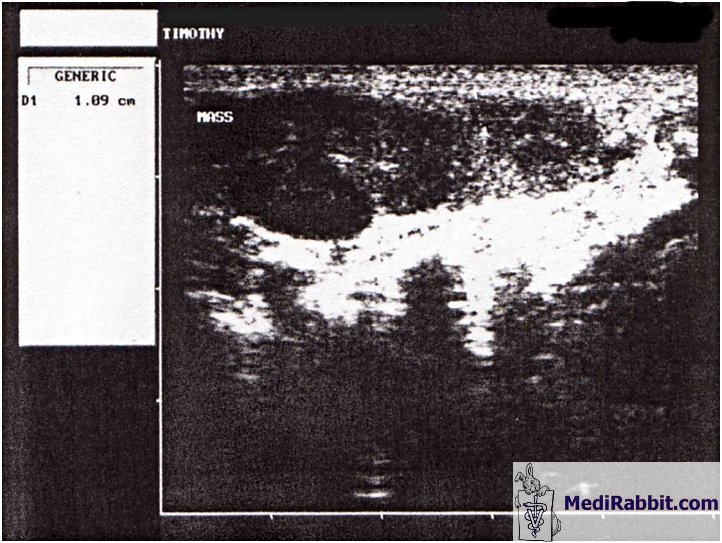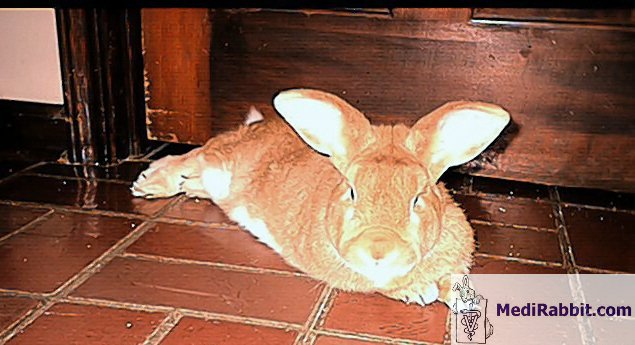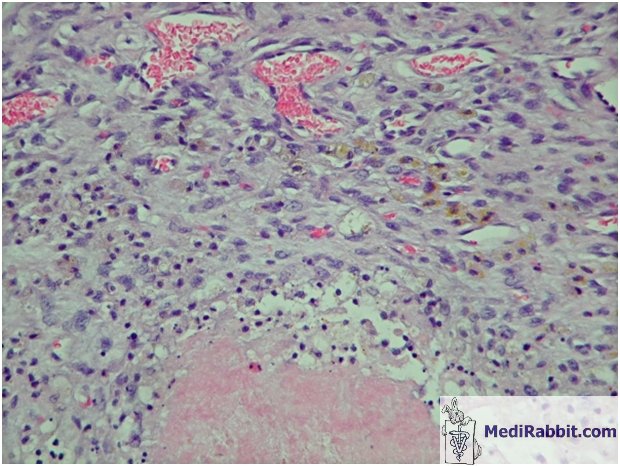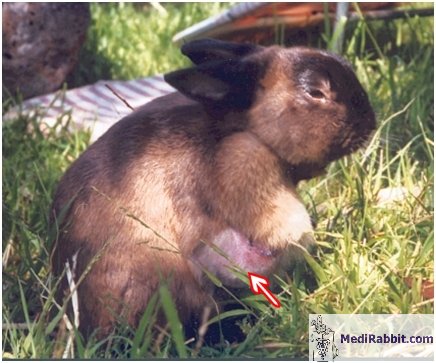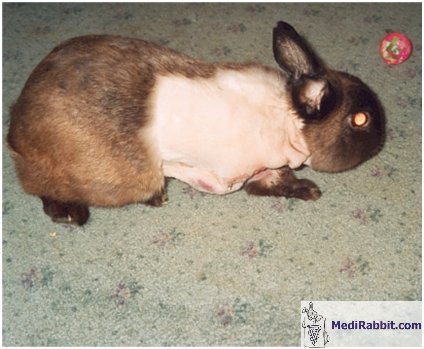Fibrosarcoma in rabbits
Esther van
Praag, Ph.D.
|
MediRabbit.com is
funded solely by the generosity of donors. Every
donation, no matter what the size, is appreciated and will aid in the
continuing research of medical care and health of rabbits. Thank you |
Warning: this file
contains pictures that may be distressing to some persons
|
The word “sarcoma” comes from the Greek and means
“fleshy growth”. Sarcoma is nowadays used to describe relatively rare a group
of malignant tumors that involve the connective tissue. Although sarcomas are
well-recognized tumors, their characteristics lead to confusion. Indeed, some
type of sarcoma may present a combination of features of various different types
of sarcoma. This lead to the widely accepted conclusion that the neoplastic
development of a primitive mesenchymal cell can lead into different
direction, thus different types of sarcoma. The tumors are found is all parts of the body:
forelimbs, hind limbs, chest, and abdomen; as well as in all types of
tissues: muscle tissue, nerves, tendons, scar tissue, bones and their lining.
Four
principles apply for sarcoma tumors: • Location: a superficially located tumor is
less likely to be malignant than a deeper located tumor; • Size: bigger tumors are more likely to
become malignant than small tumors; • Growth:
rapid growth tumors are more likely to be malignant than slow growing ones. Fibrosarcoma seems more frequent in rabbits as
generally assumed. These mesenchymal tumors are aggressive, have generally a
rapid growth rate and are invasive into surrounding tissues, e.g. muscle or
periosteum (tissue lining bones). Indirect invasion of transport of a
metastatic cell via the blood stream is possible and metastasis can form in
the lungs, heart, kidneys and lymph nodes. A virus called "malignant rabbit fibroma
virus" has been isolated in rabbits and can lead to fibrosarcoma.
It presents antigenic similarities with the fibroma and myxoma
viruses, it is thought to be a recombinant of both viruses, but this is not
yet well defined. The presence of this virus is accompanied by immunodepression, malignant tumors and infections. In rare cases, the
fibrosarcoma can present myxoid
features and will develop into a myxosarcoma. See: “Myxoid sarcoma or myxosarcoma
in rabbits”
Diagnosis and histology
The nature of the
mass and the presence of metastases must be determined. This can be
done by X-ray, ultrasound, and a biopsy.
Fibrosarcoma are heterogenous. The presence of “fishbone-shaped” fusiform
cells within a collagenic stroma is characteristic
and characteristic for a neoplasm of mesenchymal origin. Numerous
cells are undergoing mitosis. Necrotic or hemorrhagic foci are commonly
observed.
Possible treatment options
The complete excision of the fibrosarcoma lesions
is necessary. If a limb is affected, amputation is the option of choice.
Chemical treatments have been administered to rabbits suffering from
fibrosarcoma, in order to reduce the size of the tumor in
rabbits. Rabbits should be closely monitored after each treatment,
as the drugs can affect the bacterial flora of the intestine and cause
severe diarrhea. Treatment 1: • 1 mg/kg adriamycin
IV q. 3 weeks, through peripheral catheter, • Cytoxan: standard cat dose 4 days/week,
PO • L-asparaginase
(Elspar): standard cat dose, • 2mg/kg prednisone daily. Treatment 2: • Prednisone and L-asparaginase
(Elspar) alone. A characteristic of fibrosarcoma tumors is their
high rate of recurrence (according to species, up 70% within year
of surgical removal).
For detailed information on fibrosarcoma in rabbits, see: “Skin Diseases of Rabbits”, by E. van Praag, A. Maurer and T. Saarony, 408 pages, 2010. Acknowledgements
Thanks are due to
C. Harvey, DVM (USA), Susan L. (USA), Jeff Hymel (USA), and Juliet
Brown (Australia) for providing the illustrative material for this
text. Thanks are also due to Sparky and Atticus, for his patience
during picture-sessions. Further information
Flecknell P., editor Gloucester, BSAVA Manual of Rabbit Medicine
and Surgery, UK: British Small Animal Veterinary Association2000. Hillyer E.V. and Quesenberry K.E., Ferrets,
Rabbits, and Rodents: Clinical Medicine and Surgery, New York: WB
Saunders Co.1997. Janssens G, Simoens P, Muylle S, Lauwers H. Bilateral
prolapse of the deep gland of the third eyelid in a rabbit: diagnosis
and treatment. Lab Anim Sci. 1999; 49(1):105-9. Manning P.J., Ringler D.H., Newcomer C.E., The Biology of the Laboratory
Rabbit, New York: Academic Press1994. Renfrew H, Rest
JR, Holden AR. Extraskeletal fibroblastic
osteosarcoma in a rabbit (Oryctolagus cuniculus). J Small Anim Pract. 2001; 42(9):456-8.
|



